A Scientometric Analysis and Visualization of Global LEED Research
Abstract
:1. Introduction
- (1)
- Organizing the publication trends and the current status of research partnerships in the LEED research field;
- (2)
- Identifying LEED research frontiers and research hotspots through literature co-citation and keyword co-occurrence analysis;
- (3)
- Presenting the history and development of the LEED research field based on citation burst analysis;
- (4)
- Based on the above research, constructing the knowledge system of the LEED research field.
2. Research Methodology
2.1. Data Collection
- LEED (Topic) not low-energy electron diffraction (Topic) and Article (Document Types)
- Timespan: 1 March 2000 to 24 November 2021 (Publication Date)
- Collections = BIOSIS, CCC, CSCD, DIIDW, KJD, MEDLINE, SCIELO, WOS
2.2. Data Analysis
3. Results and Discussion
3.1. Descriptive Analysis
3.1.1. Trend of Publications
3.1.2. Journal Analysis
3.1.3. Co-Authorship Analysis
Authors
Institutions
Countries
3.2. Thematic Analysis
3.2.1. High Co-Citation Literature of LEED
3.2.2. Main Research Areas of LEED
3.2.3. LEED Research Hotspots
3.2.4. The Research Process of LEED
3.3. Knowledge Graph for LEED
4. Conclusions and Future Trends
- (1)
- The literature in the LEED research field has been increasing year by year. It has increased substantially since 2006 and has been steadily increasing every year since then;
- (2)
- The most highly cited journals in the LEED research field are Building and Environment, Energy and Buildings, and Building Research and Information;
- (3)
- In the field of LEED research, there are some prominent researchers such as Svetlana Pushkar, Walaa S.E. Ismaeel, Zhonghua Guo, etc. However, the overall status of the author collaboration network shows that a small number of researchers have close and concentrated collaborative relationships. The majority of researchers are still scattered, lacking close collaborative relationships and strong academic ties with other researchers;
- (4)
- The most prominent research institutions in the LEED research field are Hong Kong Polytechnic University and Arizona State University, and the most prominent countries are the United States, followed by China, Canada, and the United Kingdom;
- (5)
- As shown in Figure 7, the main areas of research frontiers in LEED are research on GBRSs/tools, occupant satisfaction, rental premiums, IEQ, and existing buildings;
- (6)
- As shown in Figure 8, the research hotspots of LEED mainly cover research on the sustainability of certified buildings, post-use evaluation, simulation and optimization, and the comparative study of GBRSs;
- (7)
- The process of research in the field of LEED is derived through citation burst analysis, which reveals the evolutionary trend of research on LEED over time.
Author Contributions
Funding
Data Availability Statement
Acknowledgments
Conflicts of Interest
References
- Wang, Y.J. Research on the Design Application Method of Green Resort Based on LEED; Zhejiang University of Technology: Hangzhou, China, 2015. [Google Scholar]
- World Commission on Environment and Development. Our Common Future; Oxford University Press: Oxford, UK, 1987. [Google Scholar]
- Darko, A.; Chan AP, C.; Huo, X.; Owusu-Manu, D.-G. A scientometric analysis and visualization of global green building research. Build. Environ. 2019, 149, 501–511. [Google Scholar] [CrossRef]
- Lee, Y.S.; Kim, S.-K. Indoor environmental quality in LEED-certified buildings in the US. J. Asian Archit. Build. Eng. 2008, 7, 293–300. [Google Scholar] [CrossRef] [Green Version]
- OforiBoadu, A.; OwusuManu, D.-G.; Edwards, D.; Holt, G. Exploration of management practices for LEED projects: Lessons from successful green building contractors. Struct. Surv. 2012, 30, 145–162. [Google Scholar] [CrossRef]
- Shad, R.; Khorrami, M.; Ghaemi, M. Developing an Iranian green building assessment tool using decision making methods and geographical information system: Case study in Mashad city. Renew. Sustain. Energy Rev. 2017, 67, 324–340. [Google Scholar] [CrossRef]
- Zhang, X.; Zhan, C.; Wang, X.; Li, G. Asian green building rating tools: A comparative study on scoring methods of quantitative evaluation systems. J. Clean. Prod. 2019, 218, 880–895. [Google Scholar] [CrossRef]
- Obata, S.H.; Agostinho, F.; Almeida, C.M.V.B.; Giannetti, B.F. LEED certification as booster for sustainable buildings: Insights for a Brazilian context. Resour. Conserv. Recycl. 2019, 145, 170–178. [Google Scholar] [CrossRef]
- Leder, S.; Newsham, G.R.; Veitch, J.A.; Mancini, S.; Charles, K.E. Effects of office environment on employee satisfaction: A new analysis. Build. Res. Inf. 2016, 44, 34–50. [Google Scholar] [CrossRef] [Green Version]
- Altomonte, S.; Schiavon, S. Occupant satisfaction in LEED and non-LEED certified buildings. Build. Environ. 2013, 68, 66–76. [Google Scholar] [CrossRef]
- Schiavon, S.; Altomonte, S. Influence of factors unrelated to environmental quality on occupant satisfaction in LEED and non-LEED certified buildings. Build. Environ. 2014, 77, 148–159. [Google Scholar] [CrossRef]
- Das, P.; Wiley, J.A. Determinants of premia for energy-efficient design in the office market. J. Prop. Res. 2014, 31, 64–86. [Google Scholar] [CrossRef]
- Aroul, R.; Hansz, J. The value of “Green”: Evidence from the first mandatory residential green building program. J. Real Estate Res. 2012, 34, 27–49. [Google Scholar] [CrossRef]
- Bond, S.A.; Devine, A. Certification matters: Is green talk cheap talk? J. Real Estate Financ. Econ. 2016, 52, 117–140. [Google Scholar] [CrossRef]
- Lu, W.; Tam, V.W.Y.; Chen, H.; Du, L. A holistic review of research on carbon emissions of green building construction industry. Eng. Constr. Archit. Manag. 2020, 27, 1065–1092. [Google Scholar] [CrossRef]
- Hosseini, M.R.; Martek, I.; Zavadskas, E.K.; Aibinu, A.A.; Arashpour, M.; Chileshe, N. Critical evaluation of off-site construction research: A Scientometric analysis. Autom. Constr. 2018, 87, 235–247. [Google Scholar] [CrossRef]
- Chen, C. The CiteSpace Manual. Available online: http://cluster.ischool.drexel.edu/~cchen/citespace/CiteSpaceManual.pdf (accessed on 13 September 2014).
- Li, X.; Wu, P.; Shen, G.Q.P.; Wang, X.; Teng, Y. Mapping the knowledge domains of building information modeling (BIM): A bibliometric approach. Autom. Constr. 2017, 84, 195–206. [Google Scholar] [CrossRef]
- Jiang, Y.F.; Hou, L.Y.; Shi, T.M.; Gui, Q. A review of urban planning research for climate change. Sustainability 2017, 9, 2224. [Google Scholar] [CrossRef] [Green Version]
- Zhao, X.; Wang, S.; Wang, X. Characteristics and trends of research on new energy vehicle reliability based on the web of science. Sustainability 2018, 10, 3560. [Google Scholar] [CrossRef] [Green Version]
- Chen, C.M.; Hu, Z.G.; Liu, S.B.; Tseng, H. Emerging trends in regenerative medicine: A scientometric analysis in CiteSpace. Expert Opin. Biol. Ther. 2012, 12, 593–608. [Google Scholar] [CrossRef]
- Harzing, A.W.; Alakangas, S. Google Scholar, Scopus and the Web of Science: A longitudinal and cross-disciplinary comparison. Scientometrics 2016, 106, 787–804. [Google Scholar] [CrossRef]
- Pushkar, S.; Verbitsky, O. LEED-NCv3 silver and gold certified projects in the US: An observational study. J. Green Build. 2018, 13, 67–83. [Google Scholar] [CrossRef]
- Ismaeel, W.S.E. Drawing the operating mechanisms of green building rating systems. J. Clean. Prod. 2019, 213, 599–609. [Google Scholar] [CrossRef]
- Doan, D.T.; Ghaffarianhoseini, A.; Naismith, N.; Zhang, T.; Ghaffarianhoseini, A.; Tookey, J. A critical comparison of green building rating systems. Build. Environ. 2017, 123, 243–260. [Google Scholar] [CrossRef]
- Wu, P.; Mao, C.; Wang, J.; Song, Y.; Wang, X. A decade review of the credits obtained by LEED v2. 2 certified green building projects. Build. Environ. 2016, 102, 167–178. [Google Scholar]
- Suzer, O. A comparative review of environmental concern prioritization: LEED vs. other major certification systems. J. Environ. Manag. 2015, 154, 266–283. [Google Scholar]
- Wu, P.; Song, Y.; Shou, W.; Chi, H.; Chong, H.-Y.; Sutrisna, M. A comprehensive analysis of the credits obtained by LEED 2009 certified green buildings. Renew. Sustain. Energy Rev. 2017, 68, 370–379. [Google Scholar] [CrossRef]
- Awadh, O. Sustainability and green building rating systems: LEED, BREEAM, GSAS and Estidama critical analysis. J. Build. Eng. 2017, 11, 25–29. [Google Scholar] [CrossRef]
- Illankoon, I.M.C.S.; Tam, V.W.Y.; Le, K.N.; Shen, L. Key credit criteria among international green building rating tools. J. Clean. Prod. 2017, 164, 209–220. [Google Scholar] [CrossRef]
- Mattoni, B.; Guattari, C.; Evangelisti, L.; Bisegna, F.; Gori, P.; Asdrubali, F. Critical review and methodological approach to evaluate the differences among international green building rating tools. Renew. Sustain. Energy Rev. 2018, 82, 950–960. [Google Scholar] [CrossRef]
- Asdrubali, F.; Baldinelli, G.; Bianchi, F.; Sambuco, S. A comparison between environmental sustainability rating systems LEED and ITACA for residential buildings. Build. Environ. 2015, 86, 98–108. [Google Scholar] [CrossRef]
- Newsham, G.R.; Mancini, S.; Birt, B.J. Do LEED-certified buildings save energy? Yes, but…. Energy Build. 2009, 41, 897–905. [Google Scholar] [CrossRef]
- Pedro, J.; Silva, C.; Pinheiro, M.D. Scaling up LEED-ND sustainability assessment from the neighborhood towards the city scale with the support of GIS modeling: Lisbon case study. Sustain. Cities Soc. 2018, 41, 929–939. [Google Scholar] [CrossRef]
- Geng, Y.; Lin, B.; Zhu, Y. Comparative study on indoor environmental quality of green office buildings with different levels of energy use intensity. Build. Environ. 2020, 168, 106482. [Google Scholar] [CrossRef]
- Abdallah, M.; El-Rayes, K. Multiobjective optimization model for maximizing sustainability of existing buildings. J. Manag. Eng. 2016, 32, 04016003. [Google Scholar] [CrossRef]
- Sun, X.; Gou, Z.; Lu, Y.; Tao, Q. Strengths and weaknesses of existing building green retrofits: Case study of a LEED EBOM gold project. Energies 2018, 11, 1936. [Google Scholar] [CrossRef] [Green Version]
- USGBC. LEED for Existing Buildings: Operations & Maintenance Recertification Guidance; U.S. Green Building Council: Washington, DC, USA, 2009. [Google Scholar]
- Abdallah, M.; El-Rayes, K.; Liu, L. Economic and GHG emission analysis of implementing sustainable measures in existing public buildings. J. Perform. Constr. Facil. 2016, 30, 04016055. [Google Scholar] [CrossRef]
- Azhar, S.; Carlton, W.A.; Olsen, D.; Ahmad, I. Building information modeling for sustainable design and LEED® rating analysis. Autom. Constr. 2011, 20, 217–224. [Google Scholar] [CrossRef]
- Turner, C.; Frankel, M.; Council, U.G.B. Energy performance of LEED for new construction buildings. New Build. Inst. 2008, 4, 1–42. [Google Scholar]
- Lee, Y.S.; Guerin, D.A. Indoor Environmental Quality Related to Occupant Satisfaction and Performance in LEED-certified Buildings. Indoor Built Environ. 2009, 18, 293–300. [Google Scholar] [CrossRef]
- Haapio, A.; Viitaniemi, P. A critical review of building environmental assessment tools. Environ. Impact Assess. Rev. 2008, 28, 469–482. [Google Scholar] [CrossRef]
- Scofield, J.H. Do LEED-certified buildings save energy? Not really…. Energy Build. 2009, 41, 1386–1390. [Google Scholar] [CrossRef]
- Fuerst, F.; McAllister, P. Green noise or green value? Measuring the effects of environmental certification on office values. Real Estate Econ. 2011, 39, 45–69. [Google Scholar]
- Eichholtz, P.; Kok, N.; Quigley, J.M. Doing well by doing good? Green office buildings. Am. Econ. Rev. 2010, 100, 2492–2509. [Google Scholar]
- Scofield, J.H. Efficacy of LEED-certification in reducing energy consumption and greenhouse gas emission for large New York City office buildings. Energy Build. 2013, 67, 517–524. [Google Scholar] [CrossRef] [Green Version]
- Eichholtz, P.; Kok, N.; Quigley, J.M. The economics of green building. Rev. Econ. Stat. 2013, 95, 50–63. [Google Scholar] [CrossRef]
- Newsham, G.R.; Birt, B.J.; Arsenault, C.; Thompson, A.J.L.; Veitch, J.A.; Mancini, S.; Galasiu, A.D.; Gover, B.N.; Macdonald, I.A.; Burns, G.J. Do ‘green’ buildings have better indoor environments? New evidence. Build. Res. Inf. 2013, 41, 415–434. [Google Scholar] [CrossRef]
- Zuo, J.; Zhao, Z.Y. Green building research-current status and future agenda: A review. Renew. Sustain. Energy Rev. 2014, 30, 271–281. [Google Scholar] [CrossRef]
- Ma, J.; Cheng, J.C.P. Data-driven study on the achievement of LEED credits using percentage of average score and association rule analysis. Build. Environ. 2016, 98, 121–132. [Google Scholar] [CrossRef]
- Shan, M.; Hwang, B. Green building rating systems: Global reviews of practices and research efforts. Sustain. Cities Soc. 2018, 39, 172–180. [Google Scholar] [CrossRef]
- Zhang, Y.; Wang, J.; Hu, F.; Wang, Y. Comparison of evaluation standards for green building in China, Britain, United States. Renew. Sustain. Energy Rev. 2017, 68, 262–271. [Google Scholar] [CrossRef]
- Kacar, B.; Turhan, E.; Dalkiran, A.; Karakoc, T.H. Green Airport building certification comparison: A practical approach for Airport Management. Int. J. Green Energy 2022. [Google Scholar] [CrossRef]
- Salati, M.; Bragança, L.; Mateus, R. Sustainability Assessment on an Urban Scale: Context, Challenges, and Most Relevant Indicators. Appl. Syst. Innov. 2022, 5, 41. [Google Scholar] [CrossRef]
- Ferrari, S.; Zoghi, M.; Blázquez, T.; Dall’O’, G. New Level(s) framework: Assessing the affinity between the main international Green Building Rating Systems and the European scheme. Renew. Sustain. Energy Rev. 2021, 155, 111924. [Google Scholar] [CrossRef]
- Blackburne, L.; Gharehbaghi, K.; Farnes, K.; Moore, O.; Russo, M. Application of confirmatory factor analysis (CFA) as the basis of the evaluation of the green building certification systems. J. Sci. Technol. Policy Manag. 2022. [Google Scholar] [CrossRef]
- Assefa, S.; Lee, H.Y.; Shiue, F.J. Sustainability Performance of Green Building Rating Systems (GBRSs) in an Integration Model. Buildings 2022, 12, 208. [Google Scholar] [CrossRef]
- Zhang, Y.; Yin, H. Willingness to Pay for Green Office: Evidence from Shanghai. Environ. Sci. Pollut. Res. 2022. [Google Scholar] [CrossRef]
- Nkini, S.; Nuyts, E.; Kassenga, G.; Swai, O.; Verbeeck, G. Evaluation of occupants’ satisfaction in green and non-green office buildings in Dar es Salaam-Tanzania. Build. Environ. 2022, 219, 109169. [Google Scholar] [CrossRef]
- Nicolini, E. Built Environment and Wellbeing—Standards, Multi-Criteria Evaluation Methods, Certifications. Sustainability 2022, 14, 4754. [Google Scholar] [CrossRef]
- Grzegorzewska, M.; Kirschke, P. The Impact of Certification Systems for Architectural Solutions in Green Office Buildings in the Perspective of Occupant Well-Being. Buildings 2021, 11, 659. [Google Scholar] [CrossRef]
- Mahmoud, S.; Hussein, M.; Zayed, T.; Fahmy, M. Multiobjective Optimization Model for the Life Cycle Cost-Sustainability Trade-Off Problem of Building Upgrading Using a Generic Sustainability Assessment Tool. J. Constr. Eng. Manag. 2022, 148, 04022050. [Google Scholar] [CrossRef]
- Capeluto, I.G. The Unsustainable Direction of Green Building Codes: A Critical Look at the Future of Green Architecture. Buildings 2022, 12, 773. [Google Scholar]
- Ur Rehman, H.S.; Raza, M.A.; Masood, R.; Khan, M.A.; Alamgir, S.; Javed, M.A.; Roy, K.; Lim, J.B.P. A multi-facet BIM based approach for Green Building design of new multi-family residential building using LEED system. Int. J. Constr. Manag. 2022. [Google Scholar] [CrossRef]
- Mirpanahi, M.V.; Noorzai, E. Modeling the relationship between critical BIM attributes and environmental sustainability criteria using PLS-SEM technique. J. Archit. Eng. 2021, 27, 04021037. [Google Scholar] [CrossRef]
- Taher, A.H.; Elbeltagi, E.E. Integrating building information modeling with value engineering to facilitate the selection of building design alternatives considering sustainability. Int. J. Constr. Manag. 2021, 1–16. [Google Scholar] [CrossRef]
- Pushkar, S. Relationship between Project Space Types, Optimize Energy Performance Credit, and Project Size in LEED-NC Version 4 (v4) Projects: A Case Study. Buildings 2022, 12, 862. [Google Scholar] [CrossRef]
- Lee, C.L.; Gumulya, N.; Bangura, M. The Role of Mandatory Building Efficiency Disclosure on Green Building Price Premium: Evidence from Australia. Buildings 2022, 12, 297. [Google Scholar] [CrossRef]
- Akhtyrska, Y.; Fuerst, F. People or Systems: Does Productivity Enhancement Matter More than Energy Management in LEED Certified Buildings? Sustainability 2021, 13, 13863. [Google Scholar] [CrossRef]
- Al-Othmany, D.S. Green Energy Audit Approach for Public Building Integrated with the LEED Protocols. Int. Trans. J. Eng. Manag. Appl. Sci. Technol. 2022, 13, 1–14. [Google Scholar]
- Cai, H.; Wang, X.; Kim, J.H.; Gowda, A.; Wang, M.; Mlade, J.; Farbman, S.; Leung, L. Whole-building life-cycle analysis with a new GREET® tool: Embodied greenhouse gas emissions and payback period of a LEED-Certified library. Build. Environ. 2022, 209, 108664. [Google Scholar] [CrossRef]
- Huang, J.; Abadi, M.; Manu, P.; Cheung, C. Exploring the impact of applying sustainability rating systems on health and safety in building projects: A systematic literature review. Proc. Inst. Civil Eng. Manag. Procure. Law 2017, 170, 283–293. [Google Scholar]
- Durdyev, S.; Mohandes, S.R.; Tokbolat, S.; Sadeghi, H.; Zayed, T. Examining the OHS of green building construction projects: A hybrid fuzzy-based approach. J. Clean. Prod. 2022, 338, 130590. [Google Scholar] [CrossRef]
- Chen, C. CiteSpace II: Detecting and visualizing emerging trends and transient patterns in scientific literature. J. Am. Soc. Inf. Sci. Technol. 2006, 57, 359–377. [Google Scholar] [CrossRef] [Green Version]
- Yang, J.; Cheng, C.; Shen, S.; Yang, S. Comparison of complex network analysis software: CiteSpace, SCI 2 and Gephi. In Proceedings of the 2017 IEEE 2nd International Conference on Big Data Analysis (ICBDA), Beijing, China, 23 October 2017; pp. 169–172. [Google Scholar]
- Fu, J.; Ding, J.D. Comparison of visualization principles between CiteSpace and VOSviewer. J. Lib. Inf. Sci. Agric. 2019, 31, 31–37. [Google Scholar]
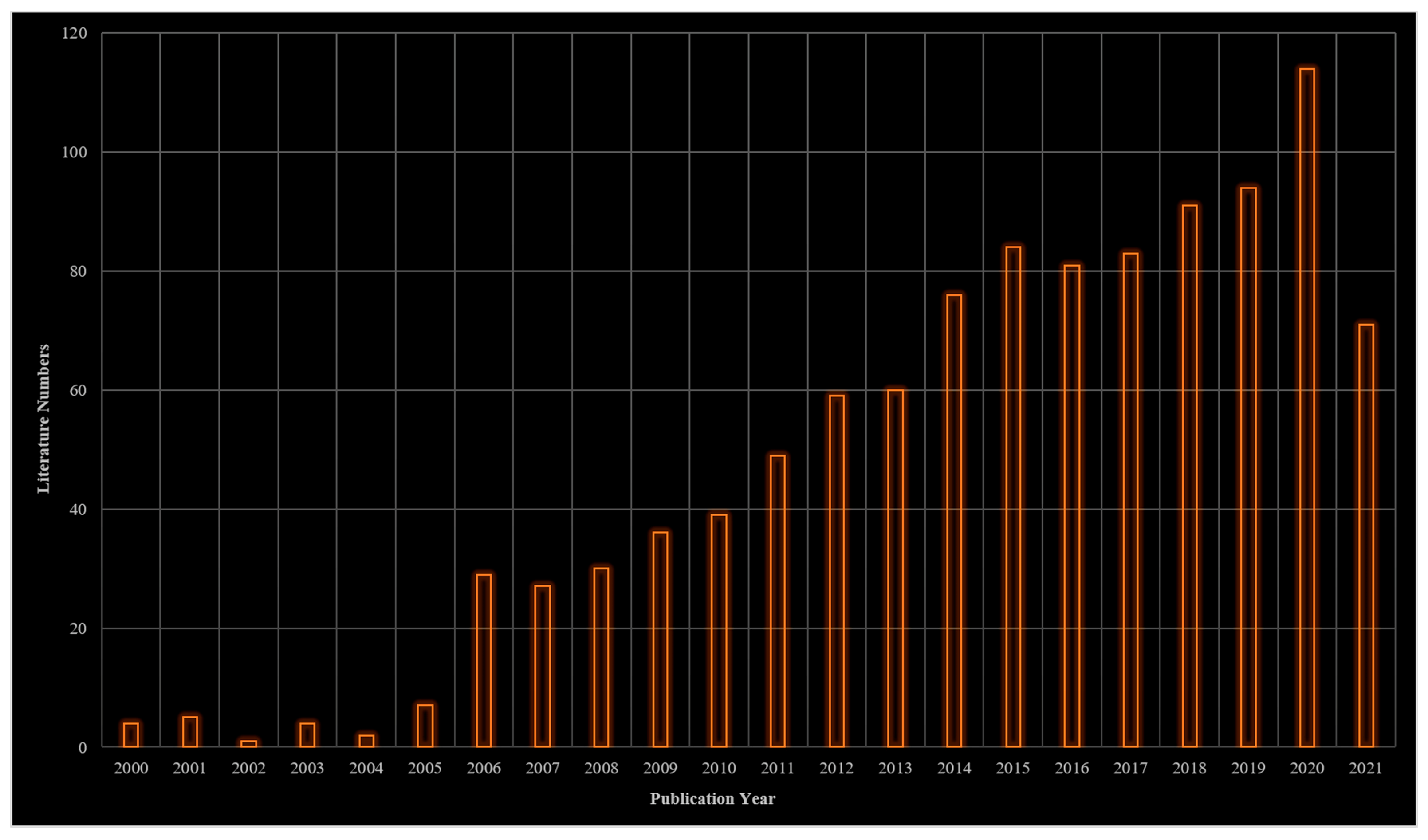
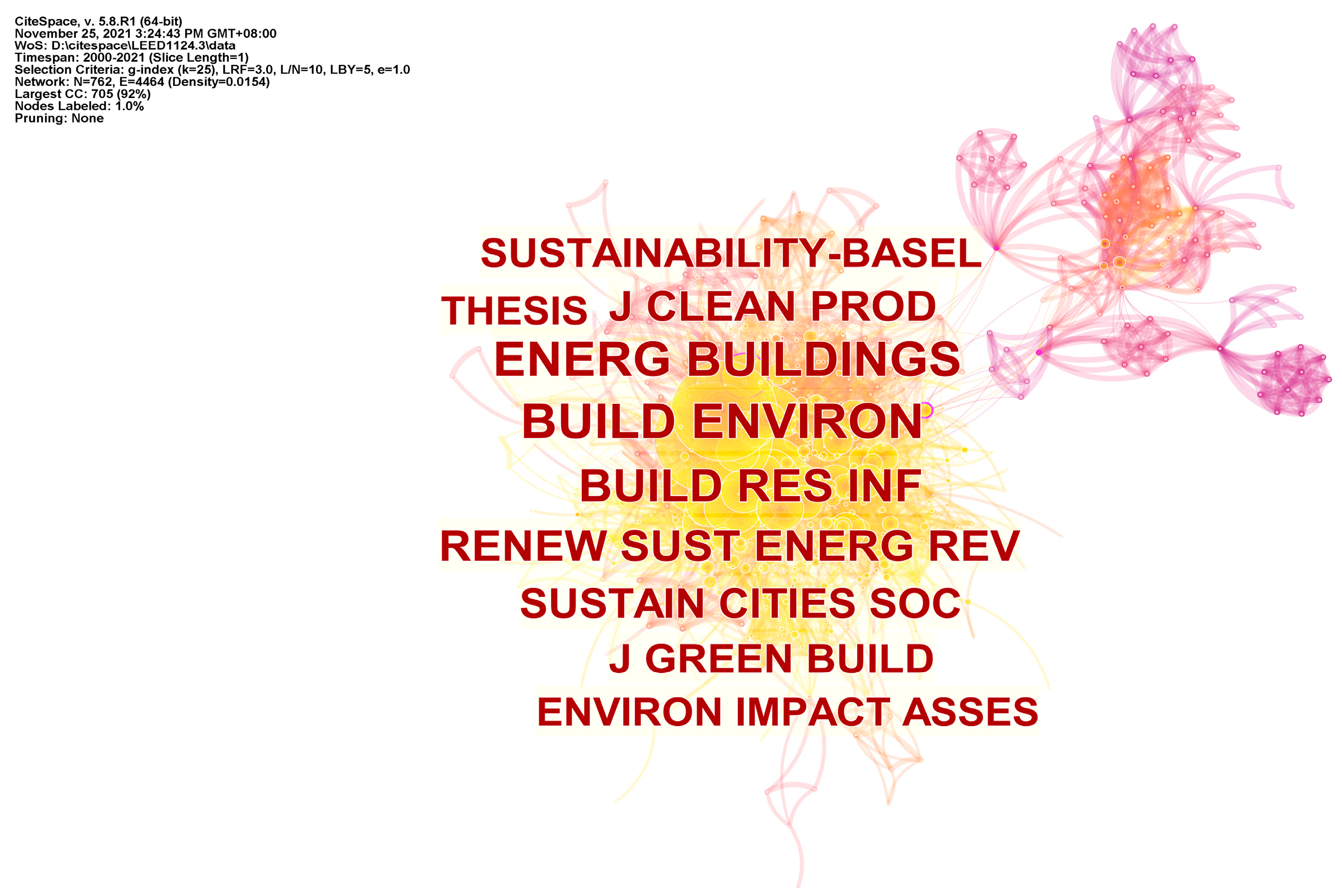

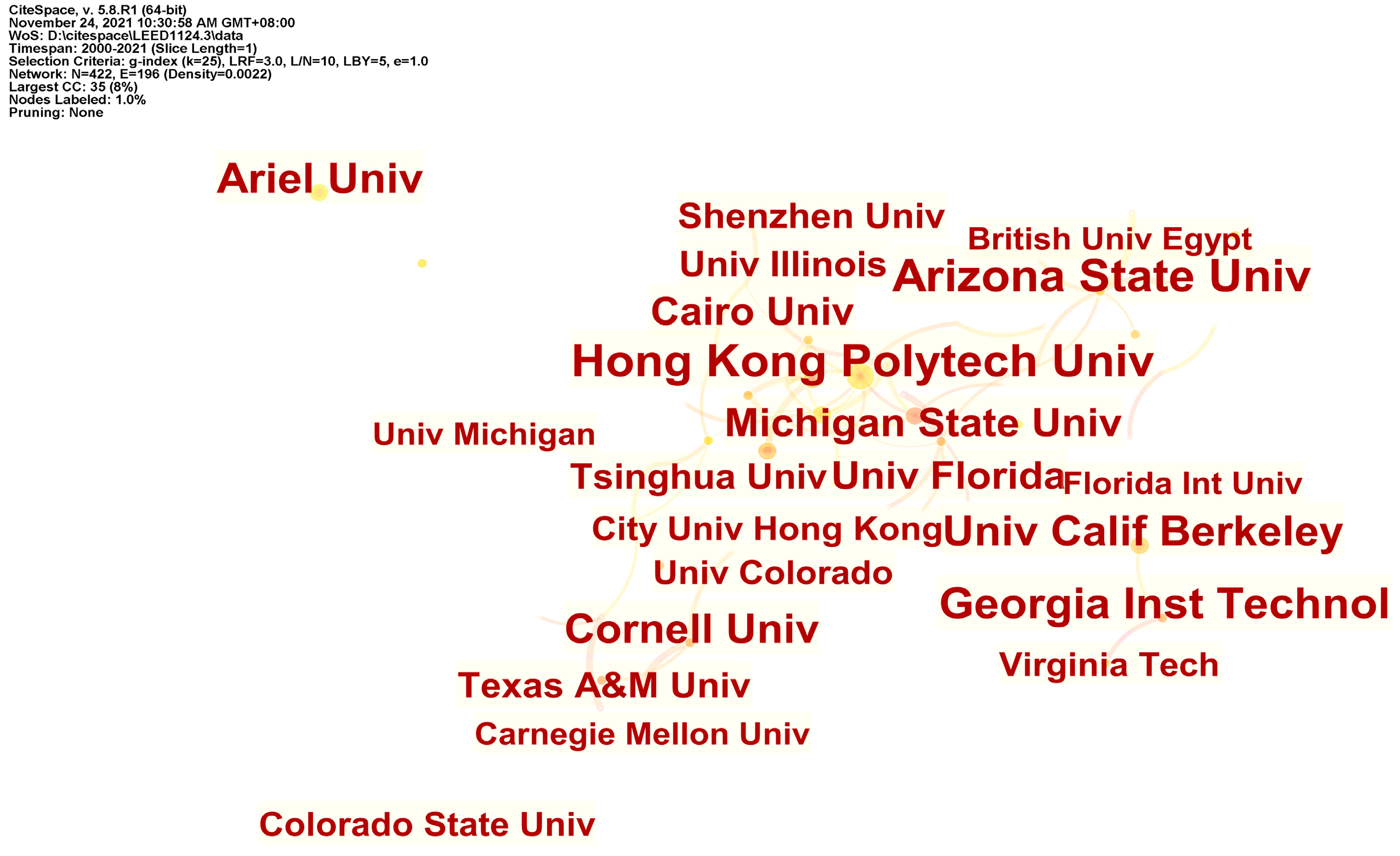
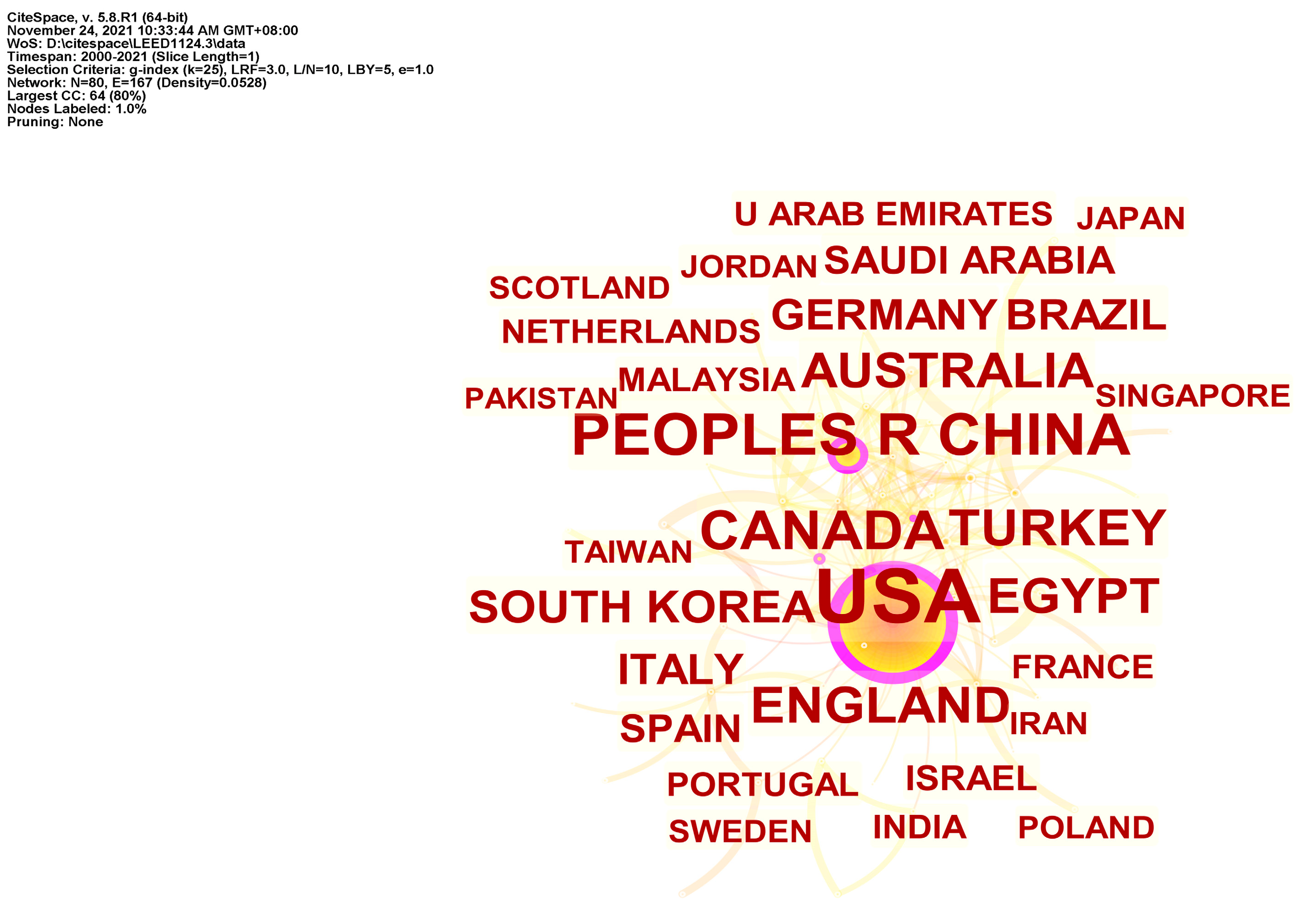
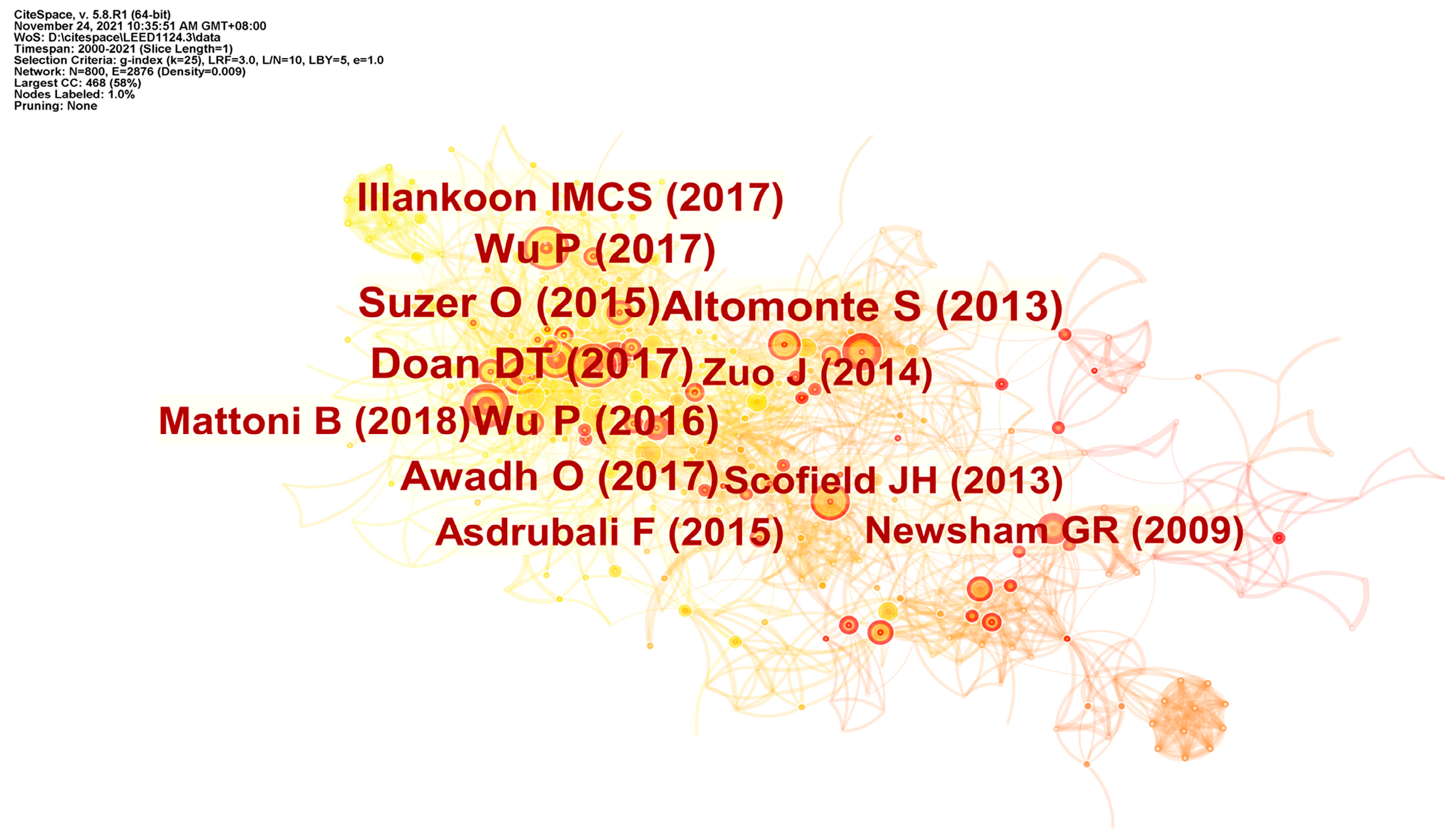

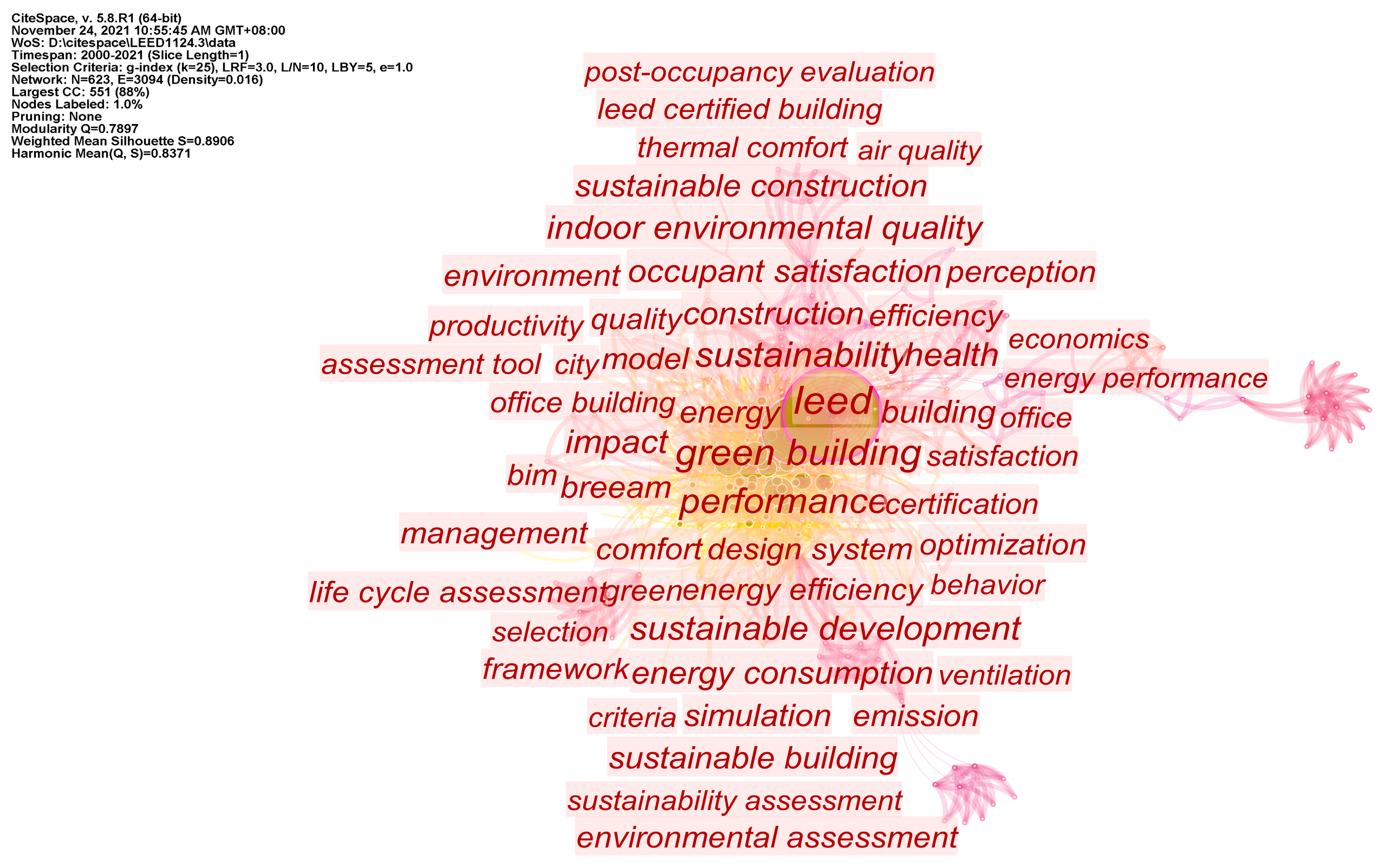
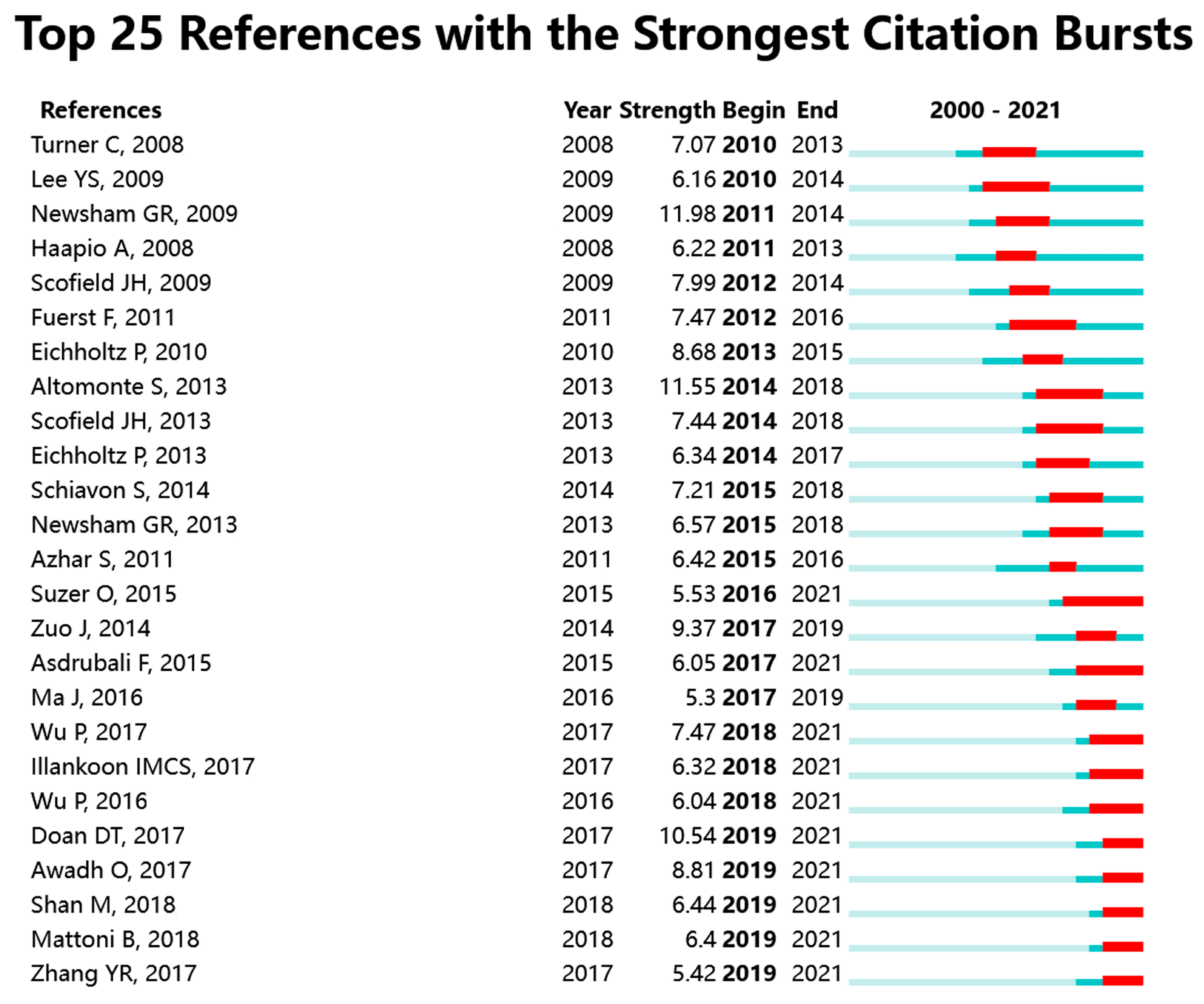
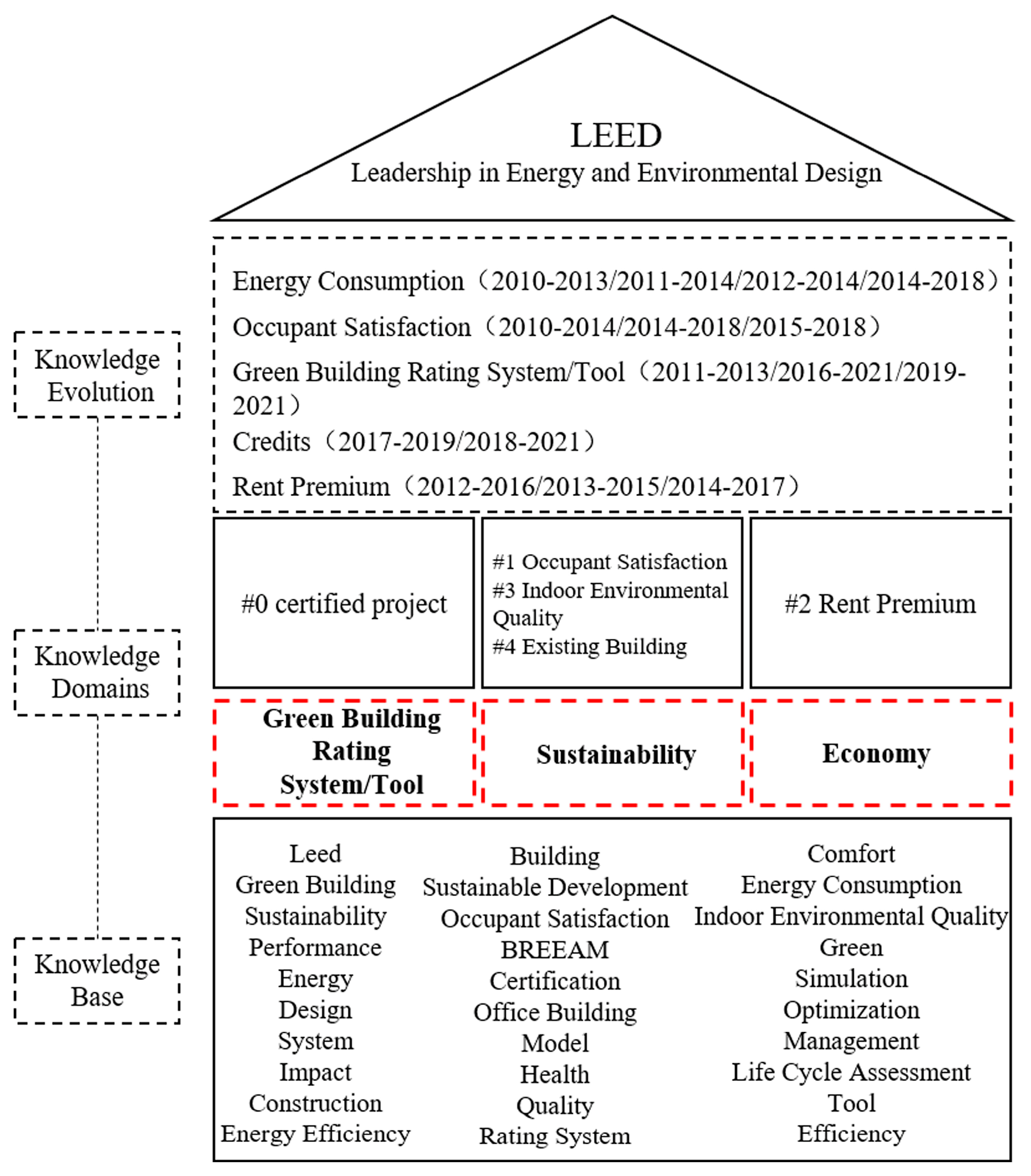
| Publication Titles | Literature Numbers |
|---|---|
| Journal of Green Building | 125 |
| Building and Environment | 71 |
| Sustainability | 61 |
| Energy and Buildings | 40 |
| Journal of Cleaner Production | 31 |
| Sustainable Cities and Society | 25 |
| Building Research and Information | 16 |
| Journal of Architectural Engineering | 15 |
| ASHRAE Journal | 13 |
| Energies | 13 |
| Author | Title | Year | Freq. | Source |
|---|---|---|---|---|
| Doan, D.T.; Ghaffarianhoseini, A.; Naismith, N. [25] | A Critical Comparison of Green Building Rating Systems | 2017 | 39 | Building and Environment |
| Altomonte, S.; Schiavon, S. [10] | Occupant Satisfaction in LEED and Non-LEED Certified Buildings | 2013 | 37 | Building and Environment |
| Wu, P.; Mao, C.; Wang, J. [26] | A Decade Review of The Credits Obtained By LEED v2. 2 Certified Green Building Projects | 2016 | 36 | Building and Environment |
| Suzer, O. [27] | A Comparative Review of Environmental Concern Prioritization: LEED Vs Other Major Certification Systems | 2015 | 34 | Journal of Environmental Management |
| Wu, P.; Song, Y.; Shou, W. [28] | A Comprehensive Analysis of The Credits Obtained By LEED 2009 Certified Green Buildings | 2017 | 33 | Renewable and Sustainable Energy Reviews |
| Awadh, O. [29] | Sustainability and Green Building Rating Systems: LEED, BREEAM, GSAS and Estidama Critical Analysis | 2017 | 32 | Journal of Building Engineering |
| Illankoon, I. M. C. S.; Tam, V. W. Y.; Le, K. N. [30] | Key credit criteria among international green building rating tools | 2017 | 28 | Journal of Cleaner Production |
| Mattoni, B.; Guattari, C.; Evangelisti, L. [31] | Critical review and methodological approach to evaluate the differences among international green building rating tools | 2018 | 25 | Renewable and Sustainable Energy Reviews |
| Asdrubali, F.; Baldinelli, G.; Bianchi, F. [32] | A comparison between environmental sustainability rating systems LEED and ITACA for residential buildings | 2015 | 25 | Building and Environment |
| Newsham, G. R.; Mancini, S.; Birt, B. J. [33] | Do LEED-certified buildings save energy? Yes, but…. | 2009 | 24 | Energy and Buildings |
| Cluster ID | Size | Silhouette | Mean (Year) | Label (LLR) |
|---|---|---|---|---|
| 0 | 129 | 0.888 | 2017 | certified project; green building rating tool; green building rating system; sustainable building assessment method; brazilian context |
| 1 | 95 | 0.853 | 2012 | occupant satisfaction; gis modeling; city scale; leed-nd sustainability assessment; lisbon case study |
| 2 | 76 | 0.863 | 2010 | rent premium; sustainable real estate; sustainable building construction; high performance; office market |
| 3 | 74 | 0.871 | 2014 | indoor environmental quality; occupant satisfaction; indoor environment quality; green office building; indoor environmental quality tradeoff |
| 4 | 31 | 0.932 | 2011 | existing building; ghg emission analysis; existing public building; green building certification process; residential high-rise building |
| No. | Freq. | Keywords | No. | Freq. | Keywords |
|---|---|---|---|---|---|
| 01 | 352 | leed | 16 | 38 | office building |
| 02 | 206 | green building | 17 | 37 | model |
| 03 | 170 | sustainability | 18 | 34 | health |
| 04 | 123 | performance | 19 | 31 | quality |
| 05 | 80 | energy | 20 | 30 | rating system |
| 06 | 74 | design | 21 | 29 | comfort |
| 07 | 69 | system | 22 | 28 | energy consumption |
| 08 | 69 | impact | 23 | 27 | indoor environmental quality |
| 09 | 57 | construction | 24 | 27 | green |
| 10 | 51 | energy efficiency | 25 | 26 | simulation |
| 11 | 49 | building | 26 | 24 | optimization |
| 12 | 45 | sustainable development | 27 | 23 | management |
| 13 | 42 | occupant satisfaction | 28 | 22 | life cycle assessment |
| 14 | 42 | BREEAM | 29 | 22 | tool |
| 15 | 40 | certification | 30 | 22 | efficiency |
Publisher’s Note: MDPI stays neutral with regard to jurisdictional claims in published maps and institutional affiliations. |
© 2022 by the authors. Licensee MDPI, Basel, Switzerland. This article is an open access article distributed under the terms and conditions of the Creative Commons Attribution (CC BY) license (https://creativecommons.org/licenses/by/4.0/).
Share and Cite
Lei, M.; Cui, T. A Scientometric Analysis and Visualization of Global LEED Research. Buildings 2022, 12, 1099. https://doi.org/10.3390/buildings12081099
Lei M, Cui T. A Scientometric Analysis and Visualization of Global LEED Research. Buildings. 2022; 12(8):1099. https://doi.org/10.3390/buildings12081099
Chicago/Turabian StyleLei, Mingzhu, and Tong Cui. 2022. "A Scientometric Analysis and Visualization of Global LEED Research" Buildings 12, no. 8: 1099. https://doi.org/10.3390/buildings12081099






